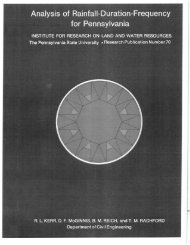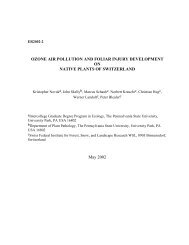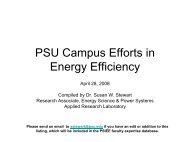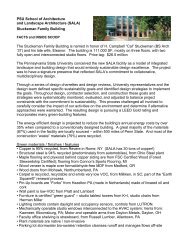Next-Generation Biofuels - Penn State Institutes of Energy and the ...
Next-Generation Biofuels - Penn State Institutes of Energy and the ...
Next-Generation Biofuels - Penn State Institutes of Energy and the ...
Create successful ePaper yourself
Turn your PDF publications into a flip-book with our unique Google optimized e-Paper software.
14 NEXT-GENERATION BIOFUELS<br />
The Chesapeake<br />
Cellulosic<br />
<strong>Bi<strong>of</strong>uels</strong> Project:<br />
A Gr<strong>and</strong> Vision<br />
I<br />
n accepting its charge from Governor Rendell <strong>and</strong> <strong>the</strong><br />
Chesapeake Bay Commission to make <strong>the</strong> Chesapeake<br />
region a leader in sustainable next-generation energy,<br />
<strong>the</strong> <strong>Bi<strong>of</strong>uels</strong> Advisory Panel developed <strong>the</strong> following vision<br />
statement:<br />
The Chesapeake Bay region will lead <strong>the</strong><br />
nation in <strong>the</strong> evolution <strong>of</strong> sustainable<br />
cellulosic <strong>and</strong> advanced bi<strong>of</strong>uel production.<br />
The words <strong>of</strong> this statement were chosen carefully.<br />
First, “evolution” recognizes that next-generation bi<strong>of</strong>uels<br />
are not possible without <strong>the</strong> utilization <strong>of</strong> first-generation<br />
technologies. Specifically, <strong>the</strong> Advisory Panel recognized<br />
that corn ethanol is a necessary national foundation for<br />
<strong>the</strong> development <strong>of</strong> infrastructure <strong>and</strong> markets that will<br />
make next-generation technologies commercially viable<br />
(see Sidebar, page 15).<br />
Second, “sustainable” refers to environmental,<br />
economic, <strong>and</strong> social factors <strong>and</strong> has been defined by <strong>the</strong><br />
Advisory Panel to include practices that result in:<br />
■ The reduction in nutrient <strong>and</strong> sediment loadings to<br />
<strong>the</strong> Chesapeake Bay <strong>and</strong> its rivers;<br />
■ Net energy benefits;<br />
■ Net greenhouse gas reductions, both direct <strong>and</strong> indirect;<br />
■ Neutrality or benefits with respect to food security<br />
<strong>and</strong> cost;<br />
■ Net social <strong>and</strong> economic benefit to affected local<br />
communities; <strong>and</strong><br />
■ No net loss <strong>of</strong> biodiversity <strong>and</strong> natural resources,<br />
including both water quality <strong>and</strong> quantity.<br />
Third, <strong>the</strong> reference to “cellulosic <strong>and</strong> advanced<br />
bi<strong>of</strong>uel” highlights <strong>the</strong> unique potential cellulosic biomass<br />
presents to <strong>the</strong> region, but encourages a flexible approach<br />
to policymaking that is favorable to <strong>the</strong> development <strong>of</strong><br />
multiple next-generation bi<strong>of</strong>uels.<br />
To achieve its vision, <strong>the</strong> Advisory Panel adopted a<br />
guiding principle <strong>and</strong> set <strong>of</strong> objectives which was used to<br />
inform all subsequent panel decisions (Sidebar, page 17).<br />
The Listening Sessions<br />
During May 2008, <strong>the</strong> Advisory Panel <strong>of</strong> <strong>the</strong> Chesapeake<br />
Cellulosic <strong>Bi<strong>of</strong>uels</strong> Project reached out to a diverse collection<br />
<strong>of</strong> stakeholders, conducting four listening sessions<br />
throughout <strong>the</strong> Bay watershed. The purpose <strong>of</strong> <strong>the</strong> listening<br />
sessions was to provide updates on goals, deliverables<br />
<strong>and</strong> timelines, <strong>and</strong> to obtain feedback on <strong>the</strong> assumptions,







